You are using an out of date browser. It may not display this or other websites correctly.
You should upgrade or use an alternative browser.
You should upgrade or use an alternative browser.
Newie question - Torque Wrenches
- Thread starter Theleman
- Start date
Currently reading:
Newie question - Torque Wrenches
Are torque wrenches useful tool to have too? Or are they must have tool?
Any using them? How do you find them? Which ones are best?
Or are they just gimmicks something that could be done without for servicing cars?
The reason for quoted torque values:
1. So it will not vibrate loose
2. So you do not strip the thread..or shear the bolt.
I quite like the ' click.stop' type.
Some just 'slip'..
Biggest issue is that they generally cover a range of torques.
Roughly equating to.
3to6mm.. 5to8mm....8to16mm..12to20mm
So..to cover anything other than 'routine'
You could need 3 or 4 dedicated wrenches.
Quite a cost..!!
Probably best to look for something covering the bulk of the 20/120Nm range
So just about everything from M6 alloy engine threads... up to suspension and wheel components.
I am lucky to have been 'hands on' for 30+ years.. and have a 'feel' for what is required..
But still advocate a calibrated device at the extremes.. or for 'fussy' applications.
Charlie
Last edited:
To add to what Varesecrazy says, there is another important reason for torque loading fasteners and that is to reduce failure due to metal fatigue. This is especially important for internal engine components and some suspension parts. By having a high pre-load the effect of cyclic loading is reduced.
If you are doing serious work like engine repairs a torque wrench is essential and one should be used when called up for other work. You will not be using it a lot so a high end one is not required.
Robert G8RPI.
If you are doing serious work like engine repairs a torque wrench is essential and one should be used when called up for other work. You will not be using it a lot so a high end one is not required.
Robert G8RPI.
I helped my brother in law check the brakes on his jtd.
Came to remount the wheels.. set the torque wrench.. then watched him 'swinging' on it.. oblivious to the fact it was clicking halfway through his swing
Probably no tighter than the 'air-tools' with the airtools though..
Came to remount the wheels.. set the torque wrench.. then watched him 'swinging' on it.. oblivious to the fact it was clicking halfway through his swing
Probably no tighter than the 'air-tools' with the airtools though..
Probably best to look for something covering the bulk of the 20/120Nm range
So just about everything from M6 alloy engine threads... up to suspension and wheel components.
I am lucky to have been 'hands on' for 30+ years.. and have a 'feel' for what is required..
But still advocate a calibrated device at the extremes.. or for 'fussy' applications.
Charlie
Great advice being given here. My most used wrench is an old Britool which does 20 to 100 lbs ft
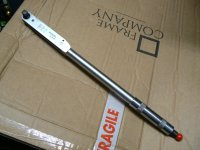
I guess it does 90% of any "torquing" I do. There is a problem with relying on torquing fixings to achieve the desired result though. Lets think about tightening down a cylinder head, which would be a typical "torquing" job. What is the objective? Well, we are trying to ensure that the cylinder head face crushes the head gasket evenly and to the required degree of "crush" against the face of the block. Yes? So why are we measuring the force required to turn the nuts/bolts? Well, if everything is optimal, so all the threads on the nuts/bolts/etc in perfect condition with no imperfections or contamination, probably lightly oiled, but check manufacturer's recommendation (and how many of us bother to do that) and the holes in the head have no problems and the faces of the nut/bolt and casting are perfect - think of anything else, there probably is? - Then, under these theoretically perfect conditions, you can probably get just about the same tensile pull registering on each fixing. If anything isn't perfect then "the games up the pole" You will not achieve the desired result precisely because you are measuring turning effort on the fixing NOT CLAMPING EFFORT HEAD TO BLOCK. Some clever people have obviously thought about this because now a days you'll find, more often than not, that head bolts, and many other fixings, are "angle tightened". When I first ran into this I didn't like it, mostly because I had got used to torquing every thing in sight! However if you think about it it's a very logical solution to the problem. Typically an angle tightening procedure will involve a reasonable level of preparation of your fixing followed by a light torquing (maybe 10, 15 or perhaps 20 ft lbs - equivalent Newton Meters are available) This is to just settle the component (head perhaps) in placed and take backlash etc out of the screw threads to give a "common" starting point for the main event. The manufacturer will have specified a very precise procedure for the angle tightening both in terms of the order in which the fixings are to be tightened and the stages in which it's to be done. A typical head may be done in two or three stages, perhaps all tightened 90 degrees, a short pause to allow settling. Then 90 degrees again and a pause. Then, perhaps 30 degrees. The great advantage to doing it this way is that it removes friction from the equation. The treads have a known pitch and the initial settling torque job makes sure the fixings are all snugged up so by turning the fixing through a certain number of degrees we know that it has advanced up its thread by an "X" amount thus bringing the head face that much nearer to the block evenly for each fixing. That, of course, is why the tightening is done in stages because a certain amount of bolt stretch will take place so you don't want to dramatically tighten one bolt more than another or it will stretch more and the whole result will be compromised. Even this is part of the equation these days with "stretch bolts" being used which go, to some extent, towards evening out the small differences as individual fixings are tightened. That's why you can only use these bolts once, If reused they will not give a predictable amount of stretch and quite possibly snap because they are already stretched before you start.
To do this angle tightening you need an angle gauge:
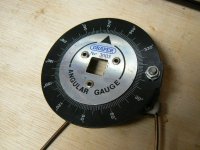
Which, I'm delighted to tell you costs peanuts, you could even make one but they're so cheap it's not worth it. The gauge is used with a socket and T bar or power bar:
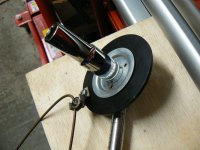

A simple piece of wire is set up against the engine block/head or wherever to stop the scale rotating as the pointer moves with the turning of the power bar.
I like the click type of torque wrench shown above and you can buy them much cheaper, but perhaps sacrificing a little on quality and accuracy, when compared to my Britool. There is a "cheap" option which I wouldn't dismiss if you're on a very tight budget and that is the "bendy" beam type:

This is actually the one I bought at college back in the '60's. It works by having a socket at the opposite end of the bar to the handle. As you apply force the socket resists turning so the thick bar (made of very high quality steel) bends. the pointer remains straight but the scale moves with the handle as the beam bends and so the pointer traverses the scale. The Americans are very keen on this design - I believe Snap On still list one? - But it requires you to be able to see the scale in use, sometimes impossible in a crowded engine bay. The accuracy is entirely reliant on the quality of metal used in that beam so avoid very cheap examples.
All torque wrenches will "drift" (go out of calibration) in time and the more they are used the quicker that will come about. The manufacturers recommend a yearly calibration for a workshop, shared, tool (possibly used every day) I use to do mine every 3 years but now retired I think every 5 will do. It ain't cheap! I was looking for a solution to this so I could do it at home (system of levers and weights) but it all got a bit silly when I started thinking about the one I use on hubs which can go to over 300 NM. Then I saw some videos on you tube about devices like this:
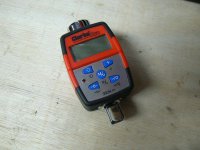

It's basically an electronic strain gauge. According to the manufacturer never (well nearly never) needs calibration and runs on cheap CR2023 button cells. My two most used wrenches had just come back from calibration. I clamped the square end of the Clarke tool in the vice (with some face protection) and the torque wrench into the square socket and tested at 1/4, 1/2 and 3/4 scale. The two readings coincided so exactly (and I did each reading 3 times for consistency) I really couldn't see any divergence. So, although I could use the electronic Clarke tool as my every day tool (well, once a month these days) I am going to keep it for checking calibration. I decided this for two reasons. First, being use so infrequently and in conditions where it is unlikely to suffer damage, it should remain super accurate. Second, It's too bulky in cramped situations. See it here Compared to the Britool:
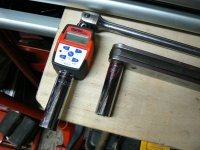
See what I mean?
So there you are. I like to torque anything which is particularly safety related, so hub nuts, caliper to carrier and carrier to hub, anything to do with suspension etc. I also like to torque engine and gearbox/drive line components. controversially perhaps, I don't usually torque wheel nuts/bolts because I like to lightly coat them with anti seize. Doing this makes them subject to overtightening if a torque wrench is used and as I've been doing this for maybe 50 years now, I've got a good feel for tightness. Never had a wheel come loose yet - Oh dear, shouldn't have said that!
PS remember to always, ALWAYS, back the adjustment back to zero when not in use on the preset "click" types. if you don't the calibration will rapidly be lost and you might as well be using a power bar from then on for all the accuracy it will give you!
Last edited:
Just rereading your original post and what you were obviously asking was - should I have/do I need - a torque wrench to do simple service work. My immediate reaction was to think back to the days when I first started "fiddling" with cars and buying a torque wrench was not top of the list. I bought my first one (the "bendy" beam) when I built up a "hot" bug engine for my friend's GP Beach Buggy - complete with high level chromed noisy exhaust!Are torque wrenches useful tool to have too? Or are they must have tool?
Any using them? How do you find them? Which ones are best?
Or are they just gimmicks something that could be done without for servicing cars?
So I think, for simple service work you could get by without. But then there's a wee niggle at the back of my mind saying "Yes but" - maybe caliper retaining bolts are better torqued if he needs to change the pads -and - If the sump is an aluminium casting the sump plugs are prone to getting stripped (a lot of workshops now insist on sump plugs being torqued to avoid this) - and - I know I don't do it but the general recommendation now a days is to torque wheel nuts - and ????
So the question I suppose, which only you can answer, is - how serious do you want to get with this? If you intend to make this a long term commitment and do all your own servicing and a fair bit, at least, of your repair work, then go for it. But take on board that once you start, the continual development and increasing complexity of modern vehicles is going to make purchasing tools and equipment an ongoing activity. It hoovers up money very easily but also saves substantial amounts compared to workshop prices - until you really b****r something up in a big way that is! Helps a lot, if you have a partner, that it's someone who is supportive too.
Welcome to my, our, addiction. Pull out now if you don't want to become a junkie!
It hoovers up money very easily but also saves substantial amounts compared to workshop prices - until you really b****r something up in a big way that is! Helps a lot, if you have a partner, that it's someone who is supportive too.
Welcome to my, our, addiction. Pull out now if you don't want to become a junkie!
Recently I started liking doing things by myself - plumbing, electric installations, plastering, painting and gardening.
When I do things myself using tools, and when things start working, getting better and repaired, and see people appreciate the changes make me feel meaning of life, rather than paying someone else to do it, and just accept their work without even knowing what & how has been done to the work.
By the way, that Silverstorm impact wrench arrived, and it seems working great. Haven't done any work with it yet, but when triggered it rotated with powerful movement.
Yes, my wife is supportive on my DIY work, and she bought me Sealey extension set for impact sockets. They look very useful for reaching awkward bolts and nuts.
I think I will go for the Torque wrenches. As I am a newbie and learning I do not need high quality expensive ones. Just simple and cheap set will do me.
Right now my Panda is going fine, but from last MOT it got advisory notes for,
Back shock absorber
Exhaust clamp missing although exhaust itself solid
Hand break cable split although works fine
Front shock absorber bushes worn
Brake disc a bit rusty although brakes work fine.
I think also it needs coolant replaced as it has not bee replaced since new 2010.
I will be looking at these points what need to be done before MOT this year.
And will do oil change by myself.
Great fun DIY on these things.
Being able to replace clutch would have been great, but maybe that is professional job needing fancy tools and know how? One day I hope I could it DIY too.
So, yes I am all for it. So I am already in it, and cannot turn back.
Last edited:
Great stuff fella! The Mot list looks like all stuff you can probably do ok. A clutch is probably a bit ambitious without guidance from someone whose done one before, although a Panda's a pretty easy one in the grand scheme of things. I am guessing yours is a 169 model 2003 to 2012? If so buy the Haynes manual, it will be a great help. I absolutely agree about the satisfaction you get from fixing something yourself, I feel this too!
I think also it needs coolant replaced as it has not bee replaced since new 2010.
Keep a close eye on coolant level. These engines (I'm guessing yours is a 1.1 or 1.2?) are very reliable and robust but don't like running low on coolant. This will often blow the head gasket! Underneath the exhaust manifold, running along the front of the engine is a black metal water (coolant) pipe it starts on the drivers side where it fits into the back of the water pump and runs along until it joins onto the radiator hose on the passenger side. there's also a smaller heater hose connection. This pipe is prone to rusting until it leaks and is also known to leak from where it seals (with a rubber ring seal) in the back of the water pump. If your water level is staying ok then there's probably nothing wrong but if your radiator level starts to drop and you can't see an obvious reason for it, it may well be this pipe. Shop4parts is a good source of high quality Fiat spares and considerably cheaper than going to the main dealer. If you spend more than a certain amount (£25.00 last time I ordered, you don't pay shipping and if you make even a small donation to the forum you can access the forum discount code.
- Joined
- Sep 18, 2018
- Messages
- 615
- Points
- 136
I don't do stuff like head gaskets, where torque is critical, so tend to work in 'grunts'.
If you tourqe all bolts to the manufacturer specifications you will have peace of mind everything is safe and just as the manufacturer intended it to be.
I had a good laugh at this - Thank you.I don't do stuff like head gaskets, where torque is critical, so tend to work in 'grunts'.
As I age I notice I grunt more loudly and more often!
I think I will go for the Torque wrenches. As I am a newbie and learning I do not need high quality expensive ones. Just simple and cheap set will do me.
I'm just slightly concerned when you talk here of "Torque wrenches" in the plural and then "simple and cheap set" This is probably just a slip in your grammar, but just in case, can I say I would just buy the one wrench to start with, probably in the 20 to 120 ft lbs range (or equivalent NM -25 to 135?) and see how you get on. A wrench in this range will deal with the more common applications.
I notice your Silverline people seem to do a 1/2" drive one at around the £20 mark which would probably suit?
I was just reflecting on what you were saying about the satisfaction and monetary saving when you DIY. About 6 months ago, late at night, as we were going upstairs to bed, half way up the stairs I felt water dripping on my head! There was an area about a meter square (hey - I just defined a measurement in metric units!) all wet with water drip, drip, dripping from the middle. Many years ago I floored our loft! so, about an hour later I had lifted 5 of the flooring chipboard panels and found it was the expansion return to tank pipe for the central heating leaking. As there was no pressure in it I temporarily wrapped it with self amalgamating tape until the morning when I cut the section out and pieced in a new bit. I've never seen this before, and I've done a lot of plumbing over the years, but, as I understand it, copper pipe is manufactured by extrusion. Looking closely at the sidewall of the pipe where the leak is I could see that some foreign body (large piece of grit or some contaminant in the die?) had been dragged along forming a short groove in the sidewall and then been pressed into the sidewall as the extrusion continued. I guess that this foreign body had originally been so tightly pressed into the wall of the pipe that it was water tight but, over the years, the heating and cooling of the pipe had caused it to loosen enough to give this wee drip!
By doing it myself I was able to immediately stop further damage to the ceiling. Knowing how the flooring had been laid I was able to take it up without damage and so reuse it at no extra cost. But, of course, the biggest saving was in labour - goodness only knows what the bill, for an emergency call out at around midnight, would have been!! So yes, DIY can be enormously satisfying, sometimes frustrating but mostly I like it because it saves shed loads of the stuff I find difficult to accumulate and rarely have enough of - MONEY!
Weather was dry and fine, I was digging up our garden most of the day moving plants. That's me just had dinner and a bit of rest and came up to pc room upstairs.
The coolant has not been checked for long time. I always used to think well I will keep watching the temp gauge on dashboard, and if it is either too hot or too low, then I will check the coolant. It was always in the middle just right, and heater comes on very warm when switched on.
But recently I see the temp gauge has gone down a wee bit. The needle is not quite in the middle but just below it. The heater is still warm, but again it feels a bit less warm than before. So I feel that coolant must be checked? Or something else could be wrong? I am not sure.
I am thinking of doing full coolant flush, and refill when I have more time.
And torque wrenches. Yes, I meant 2x of them. Silverline does one for 7 - 110nm and another one for 30-210 nm, so they are different nm range. They are about £20 each, so they are good price, and most of my silverline tools I have got, I have been happy with. So I will get 2x of them.
I will be using them working on tyres, brakes, suspension and exhaust. I doubt I will be able to work on head gaskets or clutches in the near future if at all.
And also the spark plugs and oil changes will benefit from the torque wrenches giving them near enough right torques when tightening.
On DIY, I also have saved tonnes of money by plastering the house by myself, painting as well. I also did some plumbing work replacing busted toilet flush, installing outside garden tap, and replacing sink traps. Wife absolutely love my DIY work around the house, so now I am planning to DIY on car servicing.
When I changed car battery myself, we saved about £40 - £100. I now have trolley jack, axle stands, impact wrench, impact socket set and impact socket extension kit, and car creeper.
Torque wrenches will arrive tomorrow with 4 way wheelnut wrench.
I think my wife will buy me OBD reader and car ramps
The coolant has not been checked for long time. I always used to think well I will keep watching the temp gauge on dashboard, and if it is either too hot or too low, then I will check the coolant. It was always in the middle just right, and heater comes on very warm when switched on.
But recently I see the temp gauge has gone down a wee bit. The needle is not quite in the middle but just below it. The heater is still warm, but again it feels a bit less warm than before. So I feel that coolant must be checked? Or something else could be wrong? I am not sure.
I am thinking of doing full coolant flush, and refill when I have more time.
And torque wrenches. Yes, I meant 2x of them. Silverline does one for 7 - 110nm and another one for 30-210 nm, so they are different nm range. They are about £20 each, so they are good price, and most of my silverline tools I have got, I have been happy with. So I will get 2x of them.
I will be using them working on tyres, brakes, suspension and exhaust. I doubt I will be able to work on head gaskets or clutches in the near future if at all.
And also the spark plugs and oil changes will benefit from the torque wrenches giving them near enough right torques when tightening.
On DIY, I also have saved tonnes of money by plastering the house by myself, painting as well. I also did some plumbing work replacing busted toilet flush, installing outside garden tap, and replacing sink traps. Wife absolutely love my DIY work around the house, so now I am planning to DIY on car servicing.
When I changed car battery myself, we saved about £40 - £100. I now have trolley jack, axle stands, impact wrench, impact socket set and impact socket extension kit, and car creeper.
Torque wrenches will arrive tomorrow with 4 way wheelnut wrench.
I think my wife will buy me OBD reader and car ramps
Last edited:
Top Man! wish my boys would show this much enthusiasm! Good luck with it all and please do let us know how you get on.
regards
Jock
regards
Jock
<SNIP>
I think my wife will buy me OBD reader and car ramps
For OBD, look at Multiecuscan www.multiecuscan.net It runs on a windows PC (laptop) and does sooo much more than just read codes. Needs a USB ELM327 interface and adaptor leads that costs less than £30 e.g. www.ebay.co.uk/itm/NEW-Fiat-Alfa-EL...apters-Diagnostics-Multiecuscan/282526378637?
You can play with the free version of the software without an interface by clicking simulate instead of connect.
Robert G8RPI.
This post contains affiliate links which may earn a commission at no additional cost to you.
For OBD, look at Multiecuscan www.multiecuscan.net It runs on a windows PC (laptop) and does sooo much more than just read codes. Needs a USB ELM327 interface and adaptor leads that costs less than £30 e.g. www.ebay.co.uk/itm/NEW-Fiat-Alfa-ELM-OBD2-Green-Red-Yellow-cables-adapters-Diagnostics-Multiecuscan/282526378637?
You can play with the free version of the software without an interface by clicking simulate instead of connect.
Robert G8RPI.
Great info. Thank you.
It certainly looks giving richer information than just codes of standard OBD readers.
I think she already ordered one from Amazon. The make is "JDiag 101". It also does battery tests too seemingly.
So, it is on its way, and also a set of car ramps as well.
My Panda has Engine Management Warning light come on from a few days ago, so will connect the OBD reader, and see what it says.
This post contains affiliate links which may earn a commission at no additional cost to you.
Great info. Thank you.
It certainly looks giving richer information than just codes of standard OBD readers.
I think she already ordered one from Amazon. The make is "JDiag 101". It also does battery tests too seemingly.
So, it is on its way, and also a set of car ramps as well.
My Panda has Engine Management Warning light come on from a few days ago, so will connect the OBD reader, and see what it says.
Well the good thing about online shops is you don't have to give a reason for sending it back. If you already have a suitable laptop I strongly recommend getting MES instead.
Robert G8RPI.
Well the good thing about online shops is you don't have to give a reason for sending it back. If you already have a suitable laptop I strongly recommend getting MES instead.
Robert G8RPI.
I don't have laptop. I still use 15 year old AppleMac Desktop MacPro 1.1
It died for 2 years a few year ago, but I replaced graphics card, and it has been working again. It doesn't do much due to ancient OSx 10.7, but still works OK for browsing Internets for news and forums. That's all I need for my personal computing
JDiag ODB reader is cheap and cheerful, and seems working OK too. Seems enough for my level of car knowledge now. Will get something better if needed in the future.
JDiag ODB reader is cheap and cheerful, and seems working OK too. Seems enough for my level of car knowledge now. Will get something better if needed in the future.
Well there is nothing wrong with having a basic, basic plus ODB device. Besides the full MES package I also have a Foxwell NT301 https://www.gendan.co.uk/product_FXNT301.html
Mine lives in my car and is thus always ready should something happen when away from home. When going on holiday / further away / Italy then I take the full MES kit AND the NT301.
I remember that my Croma threw a wobbly one year and put the MIL on and then went into limp mode (20mph). Can't recall what the error was but simply clearing the error down which then restored normal operation getting me out of an otherwise tricky situation.
Last edited:
Similar threads
- Replies
- 4
- Views
- 595

